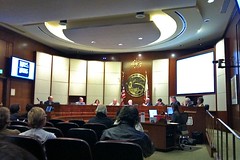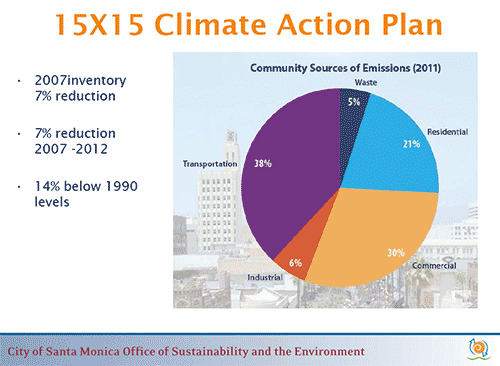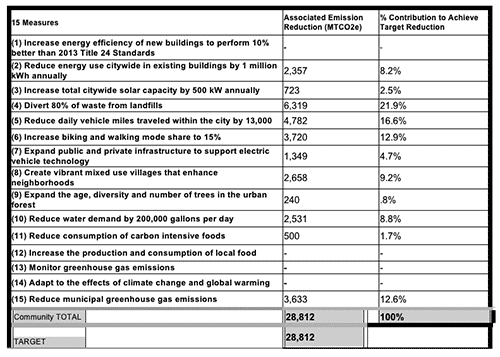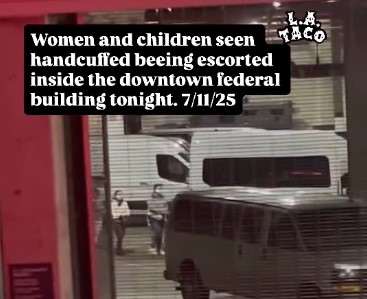At Tuesday night’s council session at Santa Monica city hall, it was a clean sweep toward making progress on multi-modal transportation goals and reducing greenhouse gas emissions (for areas not dependent on outside decision making like the federally regulated SMO airport).
The big item that most of the public was in attendance for was the proposed transportation impact fee (or TIF) on new developments, and redevelopment that intensifies land use (and does not fall into one of a handful of special exemptions). The funding generated by the TIF will be one means to help fund capital transportation projects benefiting the surrounding area, an expenditure no longer benefiting from the state redevelopment funds that were part of our pie chart before, was approved unanimously. (Item 7-E on agenda for detailed info)
Also of interesting note here on the TIF, was that mayor Pam O'Connor (also on the Metro Board & SCAG), added to the motion that the language "alternative transportation" be replaced to active transportation or transit respectively, to normalize these means of travel, rather than them being described as "alternative". A subtle switch, but the words we use matter greatly to shaping our perceptions, and shouldn't be underestimated.
The primary focus of the spending will be on active transportation since this type of inconsistent funding is best used for one off capital spending, and the biggest financial need for Big Blue Bus is in ongoing operating expenses. One early commentator during the public comment took offense to bicycle improvements targeted for more spending than for transit in one of the slides, but given the nature of this particular type of funding, I believe the staff targets presented were appropriate, and are also not set in stone at this point. Many residents expressed support for the fee and intended improvements, and Santa Monica Spoke featured a presence of a handful of speakers adding to the support for the measure.

Many from the chamber of commerce and development circles came wanting the fee dialed back, saying they supported the idea, but that it would be too burdensome as proposed. Economic models presented by staff for typical Santa Monica developments showed negligible or minor impacts to financial feasibility however. In my own public comment, echoing long time local urban policy commentator Frank Gruber, I made a suggestion that pairing this with dialing back high parking minimums in our pending zoning updates, and that can be one way to free up financing that could instead pay into these public improvements.
On the climate change and GHG emissions policy front, there were two significant items on the agenda, which I was excited to see especially after coming off of a big trip to DC to push for national policy action. The first was following the lead of the organization 350 and writer and activist Bill McKibben by approving that the city pull municipal controlled funds out of investments in the fossil fuel industry (staff report pdf). This turned out to be a very simple matter for Santa Monica, which had almost no such investments apart from the Woodlawn Cemetery funds, which the city sets guidelines for.
The second item on the agenda, and a far more ambitious undertaking, was approving a short term action plan to achieve the city’s goal of emitting 15% below 1990 levels of greenhouse gas emissions by 2015 (the SMO airport, which the city has limited direct control over until the facilities lease is up, is excluded in this particular plan). The Santa Monica 15 x 15 Climate Action Plan, line items 15 actions and sub-goals that could enable the city to hit the emissions target as well as take adaption steps as well. We are actually right on track already for the emissions target, but the measures called for in the plan assume that the population growth expected in the next few years will require the more ambitious measures to balance growth while reducing reducing emissions. (slide presentation & staff report pdf's)
Some of these items are things the city government can confront on it’s own accord, but some, like the VMT decline and mode shifts, are more complex and require more community wide actions. Although with VMT per capita on decline already, these goals may be attainable with only modest efforts to further encourage or facilitate shifts. Councilwoman Gleam Davis emphasized in her comments the need for both outreach and consistent feedback to hit some of these targets that require the entire community to make efforts.
Having become a bit of a climate hawk, and deeply troubled by our significant dependency on energy sources which are finite and increasingly destructive and costly to extract, I would say I wish we were doing more. However Santa Monica can at times be disarming when you want to raise some hell about an issue, because well, the city probably wrote a plan to address your environmental concern 15 years ago and is now measuring progress toward those goals.
I’d like to us to keep pushing even harder, especially on transportation which is our biggest source of GHG emissions, both in Santa Monica and in the state, but going the next step is a different sort of proposition to instigate than just getting scientific reality acknowledged as many are struggling to do in the United States. Perhaps we need to look for higher benchmarks outside the states, such as places like Germany, that despite clouds and fog, are kicking our butt at deploying MWh of solar energy.
For now I would like to applaud Santa Monica for keeping the ball rolling. I hope that more communities in the U.S. start pushing equally as hard or harder, and in doing so, force us to ponder more deeply where we need go next to continue leading on a transition to a sustainable relationship between humanity and the biosphere we depend on.









